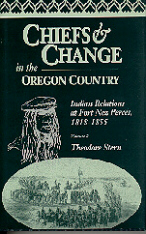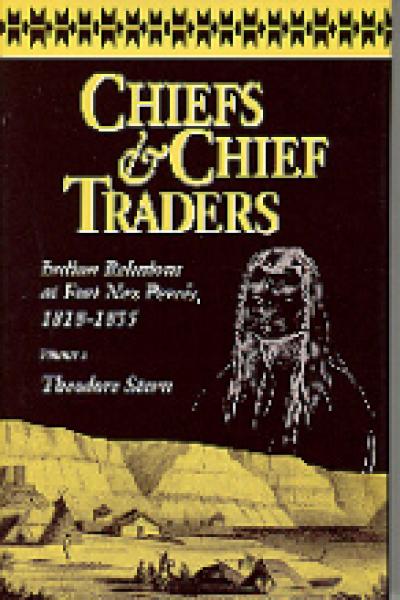
Chiefs and Change in the Oregon Country
Theodore Stern
Theodore Stern's critically acclaimed 1993 book Chiefs and Chief Traders explored early encounters between the fur traders of Fort Nez Perces and the Indians of the eastern Columbia Plateau, principally the Cayuse, Nez Perces, Wallawalla, and Umatilla. Drawing on 25 years of research, Stern recreated the dynamic relationships between Indians and whites at the small but strategic trading post near the confluence of the Columbia and Snake rivers. He offered a new perspective on interactions at the fort, one that encompassed the voices and lives of Indians as well as whites.
In a remarkable new companion volume, Chiefs and Change in the Oregon Country, Stern again focuses on the Plateau Indians, and particularly on the changes they underwent as first the Hudson's Bay Company traders, then missionaries, and later settlers, Indian agents, and the military entered their world. Stern traces these forces of change as they swept through to the Willamette Valley and details their tremendous impact on the Indians tied by residency and trade to Fort Nez Perces. He concludes his history with the fall of the fort during the Indian wars of the 1850s and the end, shortly thereafter, of independent tribal government.
Like its predecessor Chiefs and Change in the Oregon Country is a skillful weaving of history and anthropology. This major work brings important new topics and insights to the story of Indian-white relations in the Pacific Northwest.
About the author
Theodore Stern was professor emeritus of anthropology at the University of Oregon. In addition to the two books featured here, he authored The Klamath Tribe: A People and Their Reservation.
Read more about this author
Preface
List of Indians introduced in Volume I
Acknowledgments
I. Guided Change and the Company
ONE: The Red River School and the Post-Guided Change and the Company
TWO: Toward a Stronger, Yet Responsive, Chieftaincy
THREE: Contested Loyalties in the Fur Wars
II. The Missionary Programs
FOUR: Founding of the Protestant Missions
FIVE: >Developing Relationships at Waiilatpu and Lapwai
SIX: Indian Allies and Opponents at Waiilatpu
SEVEN: The Confrontation of 1841 and Its Sequels
III. A New Order Emerges
EIGHT: Freemen and Company Servants
NINE: Overland Emigrants
TEN: The Emigrant Road
ELEVEN: The Overlanders in Indian Eyes
TWELVE: Company Views of the Overlanders
IV. The Government and the Indians
THIRTEEN: Elijah White and His "Nez Perce Laws"
FOURTEEN: The Wallawalla and the Cayuse Adopt the "Laws"
FIFTEEN: The "Laws" in Action: Piupiumaksmaks and McKinlay
SIXTEEN: The "Laws" in Action: The Wascos and Cockstock's Revenge
SEVENTEEN: The "Laws" in Action: Piupiumaksmaks and Sutter
IV. The Government and the Indians
EIGHTEEN: The Attack on the Waiilatpu Station
NINETEEN: Edward Teloukaikt and a Village in Flux
TWENTY: Preparations for a War
TWENTY-ONE: The March to Waiilatpu
TWENTY-TWO: The Council of the Peace Commissioners
TWENTY-THREE: Fruitless Pursuit in the Hills
TWENTY-FOUR: Governor Lane Ends the War
VI. Administering the Indians
TWENTY-FIVE: The "Indian Problem" in Western Oregon and Federal Solutions
TWENTY-SIX: The Indian Scene in the Willamette Valley in the 1850s
TWENTY-SEVEN: The Utilla Agency
TWENTY-EIGHT: Indian Agents, Army Officers, and Bourgeois in the Upper Country
VII. Negotiating a Future
TWENTY-NINE: Governor Stevens Comes West
THIRTY: Tribes, Legislatures, and Others Make Ready
THIRTY-ONE: Doty and Thompson Prepare the Way for a Council
THIRTY-TWO: The Council Covenes
THIRTY-THREE: Overtures
THIRTY-FOUR: A Concrete Proposal: Two Reservations
THIRTY-FIVE: Secret Sessions and a Revised Proposal
VIII. The Beginning of a General War
THIRTY-SIX: The Council Bears Bellicose Fruit
THIRTY-SEVEN: The First Stages of the War
THIRTY-EIGHT: The Yakima and Walla Walla Campaigns
Epilogue
Notes
Bibliography
Index
"Theodore Stern writes… with the magisterial scholarly authority of a lifetime devoted to the understanding of the peoples of the Northwest."




